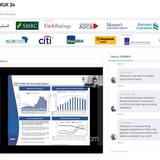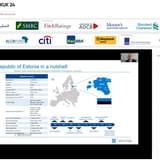Covered bonds, debt securities (remaining on an issuer’s balance sheet) often backed by cash flows from loans, commercial or residential mortgages, have a long history in Europe and gained renewed attention from investors after the credit crunch in 2008 because they were fairly resilient in comparison to other assets.
Characterised by the double protection offered to their holders (with the separation of collateralised assets in a cover pool that is actively managed) and governed by a strong regulatory framework, these instruments offer banks a strong tool with which to diversify their funding sources and appeal to large institutional investors including pension funds, insurance companies and mutual funds. According to the European Covered Bond Council, the covered bond market has developed into the most important segment of privately issued bonds on Europe’s capital markets, with roughly €2.6tn in outstanding notes at the end of 2013.
These instruments are fairly new in Turkey, with the legal framework for mortgage-backed covered bonds having only been introduced into Turkish capital markets laws in 2007 and critical amendments modelled after German covered bond legislation in 2014. But there are a number reasons why the country’s banks have in recent years moved – within quick succession – to set up covered bond programmes.
At the heart of this story is Turkey’s profound economic transformation and over the past decade and demographic makeup, which underlies the significant growth seen in the country’s real estate market during that period.
Between 2003 and 2013, Turkey’s national GDP per capita rose from US$4,559 to US$10,818. During that period, housing loan volumes increased from US$600mn in 2003 to a whopping US$51.6bn, according to data from the Association of Real Estate and Real Estate Investment Companies (Goyder), a shift driven largely by a significant increase in incomes and growing urbanisation, particularly among the country’s relatively young population. Of the 79 million people living in Turkey, almost half are under the age of 30; additionally, about 75% of the country’s inhabitants live in cities, a 25% over the past 60 years.
House sales have continued apace over the past few years as well. Between 2013 and 2015 housing sales shot up from 697,078 to 854,932, respectively, and of the houses sold in 2015, just over half – 434,388 included mortgages, according to data from Turkish statistical institute Turkistat.
These mortgages appear to be relatively safe, too, according to a report recently published by Moody’s Investor Service. Residential mortgage non-performing loans in Turkey have sat just below 1% since early 2015, while corporate NPLs by comparison rose from 5.8% to 7% during the same period. This is despite the fact that from 2010 to Q2 2015, Turkish home prices increased by about 30% in real terms and 84% in nominal terms, though housing prices in major metropolitan areas like Istanbul have dropped over the past year as inflation began to take hold. While the growth outlook for Turkey has been subdued over the past two years, there seem to be few signs of erosion in the country’s housing market or its technicals, analysts suggest. Mortgage growth has decreased as interests rates rose over the past year, which also means the likelihood of a crisis hitting the housing market is lower.
Many of Turkey’s banks traditionally rely on short term funding backed by deposits and are actively seeking ways to diversify their funding bases, which coupled with the above has led many of them to set up covered bond programmes, allowing them to tap into their mortgage base to fuel longer-term borrowing from a broader base of investors.
Deal Flow Sputters Ahead
Sekerbank, one of Turkey’s mid-sized lenders, was the first to test the country’s covered bond market in 2011 with a €335mn triple-tranche multi-currency deal coordinated by UniCredit, IFC and Netherlands-based FMO, but those notes were backed by thousands of loans to SMEs. The deal, the first covered bond transaction from an emerging market country, was very well received, with the issues pricing between 200bp–250bp over Euribor/Libor.
“It was seen as a very innovative deal at the time, and the fact that it was spread across three currencies must have made it more complex, but it was a significant deal for the bank,” recalls one investor who participated with the deal. “SME loan-backed bonds still tend to have much higher collateral risk associated with them when compared to mortgages, so it makes sense that the market has shifted towards mortgage-backed instruments.”
According to research from Moody’s the collateral risk associated with SME-backed covered bonds in Turkey sits between 14.7% and 15%, compared with the 6.8% to 7% range seen on similar instruments backed by residential mortgages.
“Now that the ECB is effectively continuing its asset buying spree, one of the main drivers early on in this market, I would imagine we are in for more issuances to come,” he says.
Denizbank and Yapi Kredi have since joined Sekerbank in setting up similar SME loan-backed covered bond programmes, but more recently – particularly since the introduction of new Capital Market Board rules on covered bonds in 2014 – other lenders have taken advantage of renewed clarity around mortgage-backed covered bonds to set up their own programmes.
The rule amendments introduced in 2014, among other things, removed the requirement for mortgages in covered pools to be backed by occupancy certificate (iskan ruhsatı). With issuers able to collateralise their programmes with mortgage loans that do not have an occupancy certificate associated with them, they can increase the value of secured receivables, the amount of eligible collateral, and the size of the cover pool.
Akbank and Garanti Bank set up their covered bond programmes, largely backed by commercial mortgages, in 2014, followed more recently by VakifBank, which established a €3bn covered bond programme in July 2015. Yapi Kredi also applied to the CMB in October last year to sell €1bn in covered bonds.
“There are a number of incentives for Turkish banks to consider mortgage covered bonds. They offer a relatively attractive funding cost compared to senior funding, investor diversification, and critically, the ability to match funds from mortgage assets, both from a funding tool and maturity perspective,” explains Batuhan Tufan, Senior Vice President, Head of Financial Institutions at Garanti Bankasi, the largest privately owned bank in Turkey.
These programmes haven’t been that large so far. Garanti Bankasi has a €5bn covered bond programme in place but has so far issued just a fifth of that, while Akbank sold about €150mn worth of mortgage-backed covered bonds in a privately placed deal two years ago. Garanti announced earlier this year that it would monitor the market and issue if timing was right and liquidity conditions were optimal.
“So far we have not been able to find the economic justification… however, we will continue to monitor the market very closely,” he says adding that similar programmes are currently in the process of being set up, which could lead to a “healthy pipeline in the near future.”
There has been just one public transaction in the mortgage covered bonds market so far: Vakifbank’s €500mn issuance back in May this year, part of the bank’s €3bn programme.
One of Vakifbank’s objectives was to access a cross-section of traditional European covered bond investors and emerging market credit investors in a bid to diversify its funding sources and open up new avenues of investments.
The deal saw huge demand from investors and by most accounts was very well received. Vakifbank released initial price thoughts in the region of MS+280bp for the €500mn transaction, shaving 30bp off the price on the back of strong demand from the market.
The orderbook was oversubscribed within 30 minutes of the start of the bookbuilding process, growing by €500mm every half an hour before a revised guidance of MS+265bp was released to the market at 10:15am London time.
By midday, orders had exceeded €3bn, which allowed the bank to tighten final spreads further to MS+250bp. The deal was finally priced at a yield of 2.578%, the lowest yield yet to be achieved by a Turkish issuer in the euro-denominated market.
“The Vakif deal was huge and managed to attract investors that don’t typically put their money in emerging markets, in part because covered bonds offer greater protection, and are higher rated than alternative fixed income instruments on offer,” says Joost Beaumont, Senior Fixed Income Strategist at ABN AMRO Bank N.V. “Despite the relative size of these covered bond programmes – between €1bn and €5bn, which is relatively small in comparison with Europe, the Vakif deal undoubtedly opened up the market for other issuers and set a new benchmark for tapping into the euro market.”
The notes saw a fairly broad distribution. About 41% of demand for Vakif’s covered bond came from Germany and Austria; 26% from the UK; 10% from Europe; 8% from the Benelux region; and 15% from other regions. Roughly 69% of the bond was picked up by fund managers, with 14% being allocated to supranational institutions, 13% to banks, with the remainder being picked up by insurance companies and pension funds.
“While the country’s banks have set up covered bond programmes, and despite the conditions being fairly supportive in many ways, we have seen just one issuance in the Euro market and a handful in the lira market,” says José de León, Senior Vice President of the Covered Bond Team at Moody’s.
“There is no question the demographics of the country position Turkey above many other emerging markets when it comes to the suitability of covered bonds. The country also has all of the necessary legislation in place, especially as of 2014, so it is farther along than most EMs in that respect.”
Part of the challenge is that Turkish covered bonds need currency swaps to hedge against mismatches between their assets (mortgages), which are denominated in Turkish lira, and liabilities – euros in this case.
To hedge against currency risk, issuers need to enter into one or multiple swap agreements with one or multiple offshore counterparties. Issuers then makes euro-denominated payments into an offshore account that is linked with a corresponding onshore account held by a counterparty receiving Turkish lira from the issuer. This way, the swap proceeds are ring-fenced.
However, the availability of lines and the additional cost burden it often adds to these transaction is a big disincentive for issuers.
“Additionally, the euro-US dollar basis swap difference is also another element that will impact the decision to issue on the overall evaluation of the cost. As such, the basis is quite wide at the moment, and even though the levels may look very attractive in euro terms, once converted into US dollar equivalent or lira equivalent, there is a high risk that such funding may not appear as attractive,” Tufan explains.
Liquidity is another concern, according to Kai Ebeling, a covered bond analyst at Norddeutsche Landesbank Girozentrale (Nord LB), one of the largest commercial banks in Germany.
“VakifBank generated a lot of interest among investors with its first covered bond. Especially the marked spread differential compared with other comparably rated covered bonds is likely to have been a crucial factor here. However, in our opinion, covered bonds from Turkey feature a not inconsiderable headline risk, which could lead to increased volatility. As a result, we expect that they will be less liquid than existing covered bond products,” he explained in a recent note.
Coup Attempt Raises Big Questions
While the Turkish lira has seen relative calm over the past 5 months, more recent events – an attempted coup in July that led to the suspension, removal or incarceration of tens of thousands of people and a state of emergency declared – have sent the lira tumbling and risk derailing the country’s economic prospects in the long term.
In the week immediately after the coup attempt the lira slumped more than 7% from 2.8782 to the US dollar down to 3.0861, and from 3.2028 against the euro to 3.3840, a drop of 5.35%. The Borsa Istanbul 100 index dropped 13.6% from 82,825.36 to 71,594.98 during the same period,
The recent events haven’t just spooked equity investors. Yapi Kredi, Turkey’s fourth largest lender, cancelled a 7-year US$550mn bond that priced on July 12 – just days before the attempted coup – after “negative developments and ensuing market volatility” deterred some fixed income investors.
Tim Ash, who leads CEEMEA strategy at Nomura says that while concerns of a prolonged post-coup attempt destabilisation of the political and economic environment are still high, the credit environment more broadly is still quite resilient.
“If you cut through the headline risk, keeping in mind that Turkey is a fairly small credit market largely dominated by blue chip companies and FIs, investors aren’t that concerned – in fact, the question I am getting now more than ever is whether now is a good time to buy more Turkish debt,” he explains. “Broadly speaking there is still a great deal of confidence in the fundamentals of the Turkish economy and the issuers that come to market.”
Spreads on Turkish bonds have widened between 70 to 80bp since July 15, though some credits are tightening back to within 60bp wide of their mark before the events unfolded.
The events have raised questions about the how covered bonds will be affected. If the currency continues to remain depressed – particularly against the euro – we could see the cost of covered bond embedded swaps rise, analysts suggest. Credit ratings are an important factor here, and with the sovereign on review for a downgrade, any action would have wide implications for Turkish assets.
“The credit rating agency also plays a huge role here – and not just within Turkey. If the swap has a certain minimum rating, which is usually ‘A-’, these banks have to be able to find another financial institution that has a sufficient rating to do these swaps, which could get more challenging as the wider global environment becomes more strained, impacting even developed market banks and other potential counterparties. It can certainly prevent them from doing new deals,” Beaumont says.
Covered bonds are resilient but not entirely immune it seems. In mid-July Moody’s placed the ratings of the covered bonds issued by six Turkish banks – Akbank, Denizbank, Garanti Bank, Sekerbank, Vakifbank, and Yapi Kredi – on review for downgrade, just days after the CRA said it would review the sovereign rating as well as the rating of 8 of the country’s largest companies including Anadolu Efes, Dogus Holding, Koc Holding, OYAK, and Tupras. The covered bonds’ ratings are currently capped at the A3 local country ceiling of Turkey. A downgrade of the sovereign could lead to a lowering of the country ceiling, and subsequently the covered bonds.
The Timely Payment Indicator (TPI), which measures the likelihood that timely payments will be made to covered bond investors following the default of the bank supporting, could also be called into question if the economic environment, and particularly the country’s banking sector, erodes further.
De León says that beyond rating actions, covered bonds are unlikely to suffer, particularly if the currency swap structure implemented by Vakifbank on its transaction is replicated on future transactions.
“They were able to setup a structure that protects against currency risk as well as exchange control risk that could be imposed by the Turkish government in case of economic shock. They were able to ring-fence euro payments from counterparties to protect from interference of the Turkish government, which is crucial for us, and one of the reasons why the bank’s covered bond was able to secure such a high rating,” he says.
“The Turkish banking system does have a negative outlook, however, which could put investors off – particularly the kinds of non-EM investors looking to pick-up covered bonds. Political issues or interference could also have a destabilising impact and negatively affect the outlook.”
Other economists have echoed concerns over government interference as one of the main risks that could influence the willingness of investors to buy into covered bonds. “While covered assets are typically well insulated from political risk or interference from the sovereign, we have seen the government move to interfere with the financial sector before,” says an economist based in Istanbul.
“Since the coup attempt in late July we have seen tens of thousands of people arrested or sacked. And while one could argue there are good reasons for the banking sector to remain untouched for the sake of stability, the government hasn’t hesitated to meddle with other important institutions in the finance universe here during calmer periods.”
The economist was referring to a time in March 2014 when Turkey’s President Tayyip Erdogan criticised the Central Bank Governor Erdem Basci over the Bank’s inability to tackle inflation, pressuring Basci to adjust interest rates. More recently, Erdogan has ordered the nation's banks to reduce mortgage lending rates by up to 4%, which most banks have complied with. Erdogan said failure to comply with the order was tantamount to treason.
The Central Bank has been on the frontlines in the battle to soothe markets in the aftermath of the coup attempt, promising unlimited liquidity to the country’s banks and cutting the commission rate for intraday liquidity to zero. In late July Turkish Deputy PM Mehmet Simsek said the government has no plans to intervene or implement capital controls, a positive sign. Inflation, at 7.46%, is still a concern but less so after dropping from highs of 9.58% seen in January, and the IMF recently noted that there doesn’t seem to be a need to revise down its growth projections for the country.
“All of the signals [Erdogan] has given so far suggests the government favours financial stability and will do what they can to appease markets.” Still, analysts suggest covered bonds are more robust than comparable assets in emerging markets and in Turkey specifically, and are likely to benefit from yield hungry investors looking for safer asset classes offering a higher payout. With the ECB looking set to continue buying corporate debt, crowding out more European investors, and while DM assets continue to see their yield curves slump, these is a golden opportunity for Turkish banks to step up their covered bond activities. The market for covered bonds, and in particular mortgage covered bonds, is still in its initial stages, but looks set to make headway this year.









